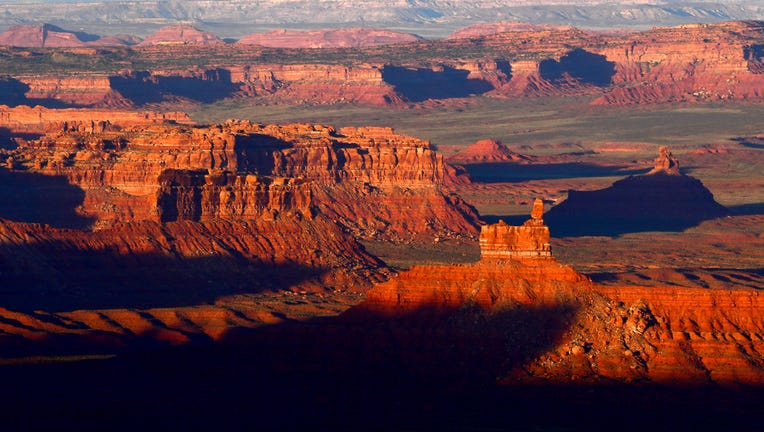Trump administration moves ahead on shrinking Utah national monuments

The sun sets over Bears Ears National Monument seen from the Moki Dugway June 11, 2017 north of Mexican Hat, UT. (Katherine Frey/The Washington Post via Getty Images)
SALT LAKE CITY - The Trump administration on Thursday implemented plans to downsize two national monuments in Utah, ensuring the lands previously off-limits to energy development will be open to mining and drilling. The action comes despite lawsuits by by conservation, tribal and paleontology groups seeking to restore the original boundaries.
The lands have generated little interest from energy companies in the two years since President Donald Trump cut the size of Bears Ears National Monument by 85% and Grand Staircase-Escalante National Monument by nearly half, said Casey Hammond, acting Assistant Secretary for Land and Minerals Management with the U. S. Department of the Interior.
Hammond said the department had a duty to work on the management plans after Trump signed his proclamations in December 2017, despite the pending lawsuits.
“If we stopped and waited for every piece of litigation to be resolved we would never be able to do much of anything around here,” he said.
Conservation groups that have called the decision the largest elimination of protected land in American history criticized the administration on Thursday for spending time on management plans they believe will become moot. They contend Trump misused the Antiquities Act to reverse decisions by previous presidents.
A federal judge last year rejected the administration’s bid to dismiss the lawsuits. In a recent court filing, tribal groups said the Bears Ears lands are “a living and vital place where ancestors passed from one world to the next, often leaving their mark in petroglyphs or painted handprints, and where modern day tribal members can still visit them.”
It’s unknown how long it will take before a judge rules on lawsuits that were filed two years ago.
“It’s the height of arrogance for Trump to rush through final decisions on what’s left of Bears Ears and Grand Staircase Escalante while we’re fighting his illegal evisceration of these national monuments in court,” said Randi Spivak, public lands director at the Center for Biological Diversity. “Trump is eroding vital protections for these spectacular landscapes. We won’t rest until all of these public lands are safeguarded for future generations.”
The biggest fear by conservationists is that the excluded lands on some of the most pristine stretches of the American Southwest will become ravaged by mining, drilling and extraction. They also worry about off-road vehicle use and logging. Government officials opted to allow off-road vehicles on designated routes in Bears Ears, for instance, rather than choosing broader closures.
President Bill Clinton created the Grand Staircase-Escalante National Monument in 1996 on lands home to cliffs, canyons, waterfalls and arches in southern Utah. President Barack Obama created Bears Ears National Monument in 2016 on a scenic swath of southern Utah with red rock plateaus, cliffs and ancient ruins on land considered sacred to tribes.
Market dynamics have limited interest in a large coal reserve found in the now unprotected lands cut from Grand Staircase and uranium on lands cut from Bears Ears.
But an economic analysis by the U.S. government estimates coal production could lead to $208 million in annual revenues and $16.6 million in royalties on lands cut from Grand Staircase. Oil and gas wells in that area could produce $4.1 million in annual revenues, the analysis says.
If interest comes as energy market forces shift, Hammond said the lands cut remain under federal control and governed by “time-tested laws” and subject to environmental regulations. He rebuffed the oft-repeated claim from conservation groups that there would be a “free-for-all” for mineral development.
“Any suggestion that these lands and resources will be adversely impacted by the mere act of being excluded from the monuments is simply not true,” Hammond said.
Trump cut the size monuments following review of 27 national monuments by then-Interior Secretary Ryan Zinke. He recommended shrinking two other monuments as well, but Trump has yet to take action.
Trump said he scaled back the size of the monuments to reverse misuse of the Antiquities Act by previous Democratic presidents that he said led to oversized monuments that hinder energy development, grazing and other uses. The move earned cheers from Republican leaders in Utah including former U.S. Sen. Orrin Hatch and current Gov. Gary Herbert.
The Bureau of Land Management posted online the voluminous and detailed management plans for the monuments, which are being sliced into non-contiguous sections rather than one large swath as in the original boundaries. The agency also created a “Myth vs Fact” web page about Bears Ears, in which it clarifies that no extraction or commercial logging is allowed within the changed boundaries.
The agency says it received about 250,500 comments about the plans, most of which were dismissed because they dealt with the size reduction, legality of that move or timing of the planning effort. Of the comments, the agency said four included valid protests that led to changes in the final plan.

